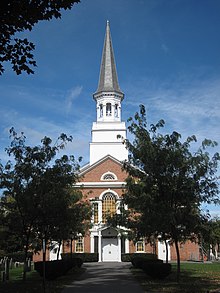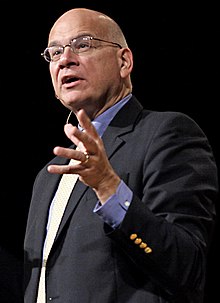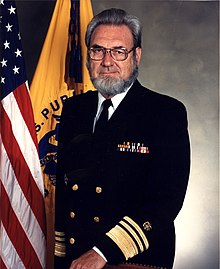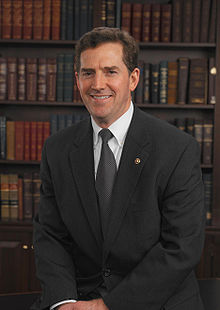Presbyterian Church in America
Another source of growth were a number of New England Puritans who left the Congregational churches because they preferred presbyterian polity.
[7] They sought to reaffirm the Westminster Confession of Faith as the fullest and clearest exposition of biblical faith, which many conservatives felt that presbyteries had been violating by receiving ministers who refused to affirm the virgin birth and bodily resurrection, and to expect all pastors and leaders to affirm the inerrancy of scripture.
[9] However, on June 23, 2016, the General Assembly of the Presbyterian Church in America voted to approve a statement on racial reconciliation that specifically recognized "corporate and historical sins, including those committed during the Civil Rights era, and continuing racial sins of ourselves and our fathers such as the segregation of worshipers by race; the exclusion of persons from Church membership on the basis of race; the exclusion of churches, or elders, from membership in the Presbyteries on the basis of race; the teaching that the Bible sanctions racial segregation and discourages inter-racial marriage; the participation in and defense of white supremacist organizations; and the failure to live out the gospel imperative that ‘love does no wrong to a neighbor’ (Romans 13:10).
During the 1970s, the denomination added a significant number of congregations outside the South when several UPCUSA churches in Ohio and Pennsylvania joined.
Such action by the Permanent Judicial Commission led to a crisis for all of those pastors and elders who held to the traditional views on this question and who were now considered heretics.
Accordingly, to uphold the peace, unity and purity of the church, most of the men who made up the membership of the charter presbytery peaceably withdrew from the UPCUSA.
Thompson, on behalf of the larger concerned group, seeking a historically Reformed body which was also evangelical and mission minded.
While this small entourage went to Macon, Georgia with many suspicions and questions, they returned overjoyed that there was an option such as the Presbyterian Church in America.
Adopted from Reformationanglicanism.blogspot July 29, 1975 A.D. Ascension Presbytery (PCA) Officially FormedFor example, seceders from Union UPCUSA formed Providence Presbyterian Church in Pittsburgh under the leadership of Broadwick.
[25] In 1982, the PCA merged with the Reformed Presbyterian Church, Evangelical Synod (RPCES), with 25,673 communicant members and 482 ministers in 189 congregations in the United States as well as in a few Canadian provinces.
[28] The move reflected a rare phenomenon in American Protestantism of two conservative denominations merging, an occurrence that was far more common among mainline, moderate-to-liberal bodies in the 20th century (such as the UPCUSA/PCUS reunion).
According to Tim Keller, the New Life Churches and their Sonship course represented classic revivalism, and it did not fit well with the more doctrinalist cast of the OPC.
[54][55] Each of the churches was allowed to withdraw with their respective properties and assets after paying a varying settlement fee to the Illiana-Florida Classis.
From the adoption of the Belhar Confession, to the removal of the conscience clauses related to women’s ordination, to the growing acceptance of homosexual practice in the denomination, we believe the RCA has changed significantly in the last several years.
Additionally, the PCA emphasizes ministries of mercy such as outreach to the poor, the elderly, orphans, Native Americans, people with physical and mental disabilities, refugees, etc.
Just as with any other sin, the PCA deals with people in a pastoral way, seeking to transform their lifestyle through the power of the gospel as applied by the Holy Spirit.
Hence, in condemning homosexual practice we claim no self-righteousness, but recognize that any and all sin is equally heinous in the sight of a holy God.
Throughout history, there has often been a conflict between the unchanging standards of biblical ethics that the Church seeks to maintain and the changing social practices of the culture.
[75] Critics sought Johnson's removal for identifying as a gay or same-sex attracted man and for arguing against Sexual orientation change efforts as ineffective.
In 2014, in response to media confusion between the PCA and the PCUSA, the stated clerk's office issued the following:[80]There are several Presbyterian denominations in America.
Throughout history, there has often been a conflict between the unchanging standards of biblical ethics that the Church seeks to maintain and the changing social practices of the culture.
The PCA ordains only men who profess traditional marriage, while the PC(USA) allows the ordination of both women and (in certain Presbyteries) non-celibate gays and lesbians as clergy.
However, there is an increasingly strong movement in the PCA to allow ordination of women as deacons including overtures in the General Assembly.
However, there is a strong New Calvinist movement in the PCA that practices contemporary music, adheres to a continuationist position on the gifts of the Holy Spirit, and engages in civil dialogue with differing theological views.
In recent years the OPC and PCA published substantial similar reports on the Creation Days, the debate about Justification and the issue of the Federal Vision.
The OPC maintains a strict cessationist position, while the PCA allows presbyteries to ordain non-cessationists if they do not believe that ongoing gifts are on par with Special Revelation.
In the five southeastern US States (Mississippi, Alabama, South Carolina, Florida, and Georgia) the PCA had 742 congregations, making up more than one third of the total 1,771 churches.
[133] When the Reformed Presbyterian Church, Evangelical Synod merged with the PCA, Canadian congregations entered the union.
[146] Approximately 15 Brazilian or Portuguese-speaking congregations was affiliated with the denomination in 2011, mainly in Massachusetts, Connecticut, New York, Georgia, New Jersey and Florida.
These International congregations can be found in the Grand Cayman Island, in Okinawa, Japan, South Korea, Prague and various cities (Berlin, Cologne, Stuttgart and Munich) in Germany.









{{
citation
}}
: CS1 maint: multiple names: authors list (
link
)
.









